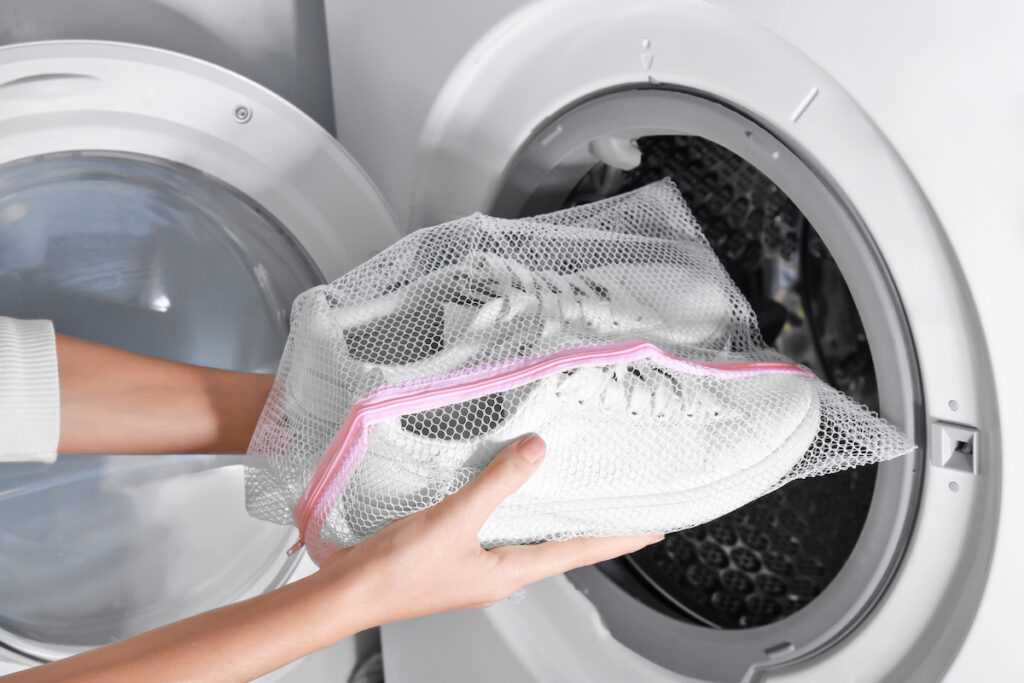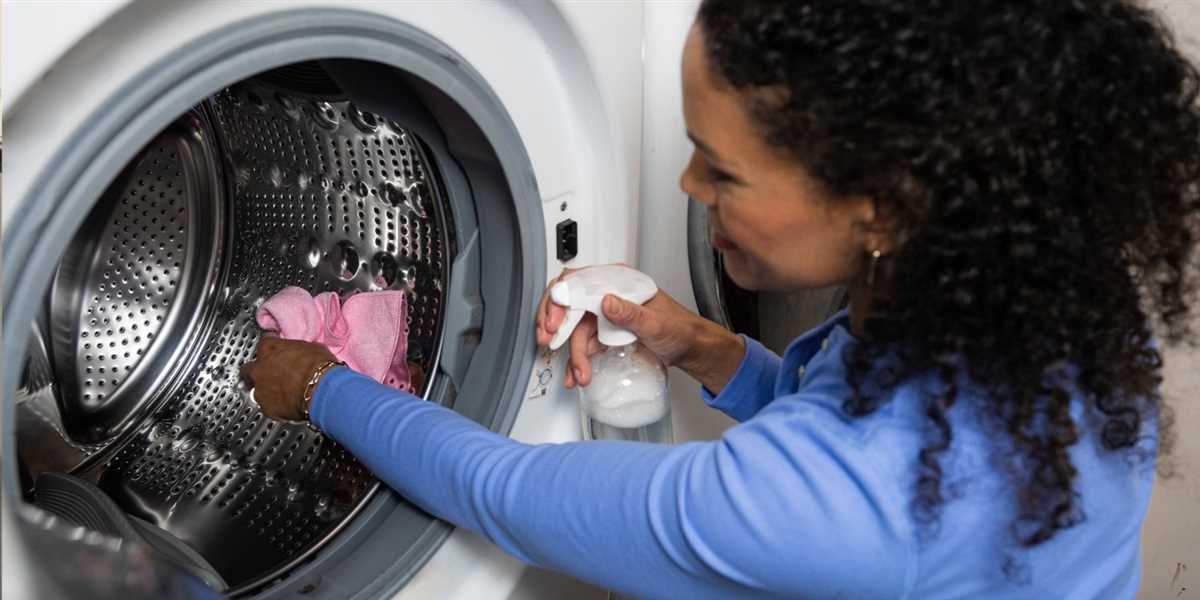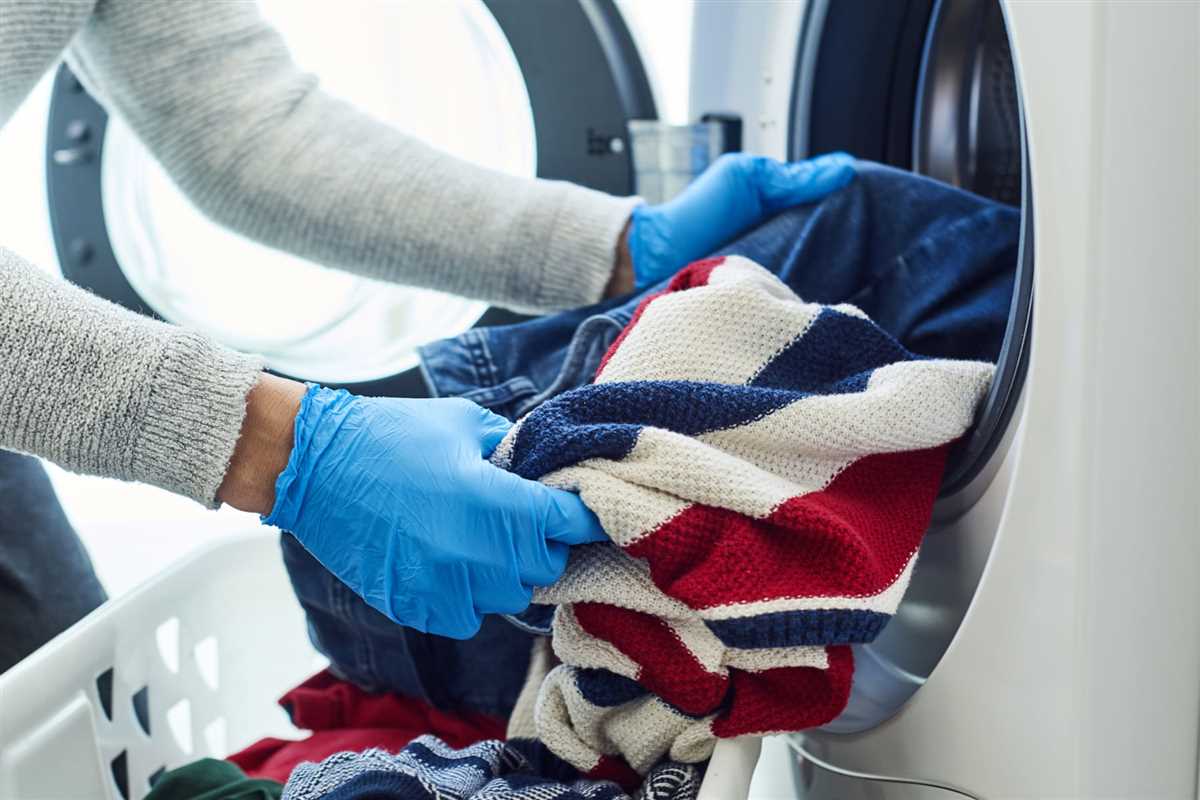


Have you ever wondered what would happen if you were put in a washing machine? While it may seem like an odd question, it’s actually an interesting scientific inquiry. In this article, we will explore the hypothetical scenario of being placed inside a washing machine and discuss the possible consequences.
Firstly, it’s important to note that being inside a washing machine would be extremely dangerous and potentially life-threatening. The mechanical motion of the machine, along with the water and detergent, could cause serious harm to the human body. Therefore, it is strongly advised against attempting such an experiment.
That being said, let’s imagine what might happen if someone were to be placed inside a washing machine. As the machine begins its cycle, the person would be subjected to a series of intense and rapid movements. The spinning drum and agitator would create a turbulent and chaotic environment, akin to being caught in a whirlpool.
The force exerted on the body would be considerable, potentially causing injuries such as bruising, broken bones, or even concussions. The water and detergent would further exacerbate the situation, possibly leading to chemical burns or other skin irritations. In addition, the person would likely experience difficulty breathing due to the lack of access to air and the presence of water.
In conclusion, being put in a washing machine would undoubtedly be a perilous situation. The combination of mechanical forces, water, and detergent would pose serious risks to the human body. It is crucial to prioritize safety and avoid any potentially harmful experiments. Remember, washing machines are designed for clothes, not people!
The Physics Behind Washing Machines
Washing machines may seem like simple household appliances, but they rely on several complex physics principles to clean your clothes effectively. Understanding the basic physics behind how washing machines work can help shed light on the intricacies of this everyday appliance.
Centrifugal Force
One of the key physics concepts at play in washing machines is centrifugal force. When the machine spins at a high speed, it creates a centrifugal force that pushes the water and detergent mixture away from the clothes towards the outer drum. This force helps to remove dirt and stains from your clothes.
Friction and Agitation
Washing machines also utilize friction and agitation to clean your clothes. As the drum rotates, the clothes rub against each other and the agitator, creating friction. This friction helps to loosen dirt particles from the fabric, allowing the detergent to dissolve and remove them more effectively.
Water and Detergent Interaction
The physics behind the interaction between water and detergent is also important in washing machines. Detergent molecules have both hydrophilic (water-loving) and hydrophobic (water-repelling) ends. When you add detergent to water, the hydrophilic ends of the molecules surround the dirt particles, while the hydrophobic ends remain in the water. This creates micelles that encapsulate the dirt, allowing it to be easily washed away.
Buoyancy and Gravity
Buoyancy and gravity are also involved in the washing process. When the drum fills with water, the clothes become buoyant, reducing the effect of gravity on them. This buoyancy helps to prevent the clothes from settling at the bottom and allows the water and detergent mixture to more effectively penetrate the fabric and remove dirt.
Rinse Cycle
In the rinse cycle, the principles of physics come into play again. The rapid spin of the drum creates a centrifugal force that pushes the water and soap residue out of the clothes and towards the drainage system. This helps to ensure that the clothes are thoroughly rinsed and free of detergent.
Conclusion
Washing machines rely on a combination of centrifugal force, friction, agitation, water and detergent interaction, buoyancy, gravity, and rinsing to effectively clean your clothes. Understanding the physics behind these processes can give you a deeper appreciation for the complexity of washing machines and how they make our lives easier.
Explore the Science Behind Washing Machine Cycles
Washing machines have become an essential appliance in our daily lives, helping us keep our clothes clean and fresh. But have you ever wondered how they actually work? Let’s delve into the science behind washing machine cycles to understand this fascinating process.
1. The Basics
At its core, a washing machine is designed to clean clothes by agitating them with water and detergent. The machine consists of several key components that work together to achieve this.
- Drum: This is where the clothes are placed for the washing cycle. It revolves both horizontally and vertically, ensuring that the clothes are thoroughly washed.
- Agitator: Some washing machines have an agitator, which is a central spindle that moves back and forth, creating turbulence in the water and helping to remove dirt from the clothes.
- Pump: The pump is responsible for circulating water in and out of the machine. It also drains the dirty water after the wash cycle is complete.
- Motor: The motor drives the drum and agitator, enabling all the necessary movements during a wash cycle.
2. The Washing Process
Now let’s look at the steps involved in a typical washing machine cycle:
- Filling: The washing machine is filled with water, which is mixed with detergent. The temperature of the water and the amount of detergent can be adjusted based on the type of clothes being washed.
- Agitation: If the washing machine has an agitator, it moves back and forth to create turbulence in the water. This helps to dislodge and remove dirt from the clothes.
- Soaking: In some cases, the clothes may be left to soak in the soapy water for a specific period. This allows the detergent to penetrate the fibers and loosen stubborn stains.
- Draining and Rinsing: After the agitation and soaking, the dirty water is drained, and fresh water is pumped into the machine for rinsing. This process helps to remove any remaining detergent or dirt from the clothes.
- Spinning: Finally, the machine goes into a spinning cycle, where the drum rotates rapidly to extract excess water from the clothes. This helps to reduce drying time and make the clothes easier to handle.
3. The Science Behind Cleaning
Washing machines use a combination of mechanical and chemical processes to clean clothes effectively.
Mechanical action, such as agitation and spinning, helps to create friction between the clothes, water, and detergent. This friction helps to dislodge dirt particles from the fabric, allowing them to be carried away by the water.
Chemical action occurs due to the presence of detergent in the water. Detergents contain surfactants, which are molecules that lower the surface tension of water and allow it to penetrate the fibers of the clothes. This helps to loosen and remove stains and dirt particles.
By understanding the science behind washing machine cycles, we can appreciate the complex processes involved in cleaning our clothes. So the next time you do your laundry, take a moment to marvel at the intricate workings of your washing machine.
Potential Risks of Being Inside a Washing Machine
While it may seem like a fun or exciting idea to imagine yourself being put in a washing machine, it is important to understand that there are significant risks involved. Your safety should always be a top priority, and participating in such activities can result in serious harm.
Possible Risks
- Injury: The spinning motion of a washing machine can cause serious injuries. The rapid rotation can cause you to be thrown against the sides of the machine, resulting in bruises, cuts, or broken bones.
- Suffocation: The confined space inside the washing machine can easily lead to suffocation. The lack of oxygen and difficulty in breathing can cause serious harm or even death.
- Entrapment: Getting trapped inside the washing machine is a significant risk. The door may get locked, preventing you from getting out. This can lead to panic, claustrophobia, and potential injury if you try to force your way out.
- Water Damage: The washing machine is filled with water during the washing process. If you were to be inside, you could suffer from water damage to your body, leading to various health issues.
Consequences
The consequences of being put in a washing machine can be severe. They may include:
- Physical injuries, such as broken bones or head trauma.
- Internal injuries due to the force of the spinning motion.
- Suffocation or difficulty in breathing, leading to asphyxiation.
- Panic attacks, anxiety, or post-traumatic stress disorder (PTSD) from the experience.
- Water-related health issues, such as infections, hypothermia, or drowning.
Conclusion
Engaging in activities like being put inside a washing machine is extremely dangerous and should never be attempted. The risks of injury, suffocation, entrapment, and water damage are too high to justify the potential thrill. Always prioritize your safety and avoid participating in dangerous activities that can result in serious harm.
Understanding the Dangers of Washing Machine Spin Cycles
Washing machines play a crucial role in our daily lives, making laundry chores much easier and more convenient. However, it is important to understand the potential dangers that can arise during the spin cycle of a washing machine.
Potential Risks
- Entrapment: There is a risk of getting trapped inside the washing machine drum, especially if the door is not securely closed. This can lead to serious injuries or even death.
- Injury from Moving Parts: The spinning action of the washing machine can cause injuries if any body parts or clothing get caught by the moving parts, such as the agitator or spin basket.
- Electrical Hazards: Water and electricity can be a dangerous combination, especially if there is a malfunction in the washing machine’s electrical system. This can lead to electric shocks or fires.
Prevention Measures
To ensure safety during the spin cycle, here are some recommended prevention measures:
- Always double-check that the washing machine door is securely closed before starting the cycle.
- Avoid overloading the washing machine, as it can affect the balance and stability during the spin cycle.
- Do not lean or sit on the washing machine while it is in operation.
- Regularly inspect the electrical cord and plug of the washing machine for any damages, and refrain from using it if any are found.
- Keep the washing machine area well-ventilated to prevent the accumulation of flammable gases from laundry detergents.
Proper Machine Usage
It is important to follow the manufacturer’s instructions and guidelines for using the washing machine correctly. Incorrect usage can increase the risks during the spin cycle. Some general tips include:
- Use appropriate detergents and fabric softeners, and follow the correct dosage.
- Sort laundry properly to avoid imbalances during the spin cycle.
- Choose the right cycle for the type of fabric being washed.
- Do not add or remove laundry during the spin cycle.
- Regularly clean the washing machine to prevent the buildup of dirt and residue.
Conclusion
Understanding the dangers associated with the spin cycle of a washing machine is essential to ensure the safety of everyone in the household. By following the recommended prevention measures and proper machine usage, the risks can be minimized, and laundry can be done safely and efficiently.
Possible Effects on the Human Body
Being put in a washing machine can have serious consequences for the human body. Here are some possible effects:
1. Drowning
One of the most immediate dangers of being in a washing machine is the risk of drowning. The enclosed space and constant movement of water can make it difficult for a person to breathe, leading to suffocation and potentially death.
2. Injury from Agitation
The agitation cycle in a washing machine involves violent spinning and tumbling of clothes. If a person were to be inside the machine, they would be subjected to this intense motion, which could result in various injuries. This may include bruises, cuts, broken bones, or even severe head trauma.
3. Temperature and Chemical Exposure

Washing machines use hot water and detergents to clean clothes. If a person is trapped inside, they may be exposed to high temperatures and potentially harmful chemicals. This could result in burns, skin irritation, or even chemical poisoning.
4. Lack of Oxygen

As the washing machine fills with water, the oxygen level decreases. This can lead to a lack of oxygen inside the machine, causing a person to feel lightheaded, dizzy, or lose consciousness. Prolonged exposure to low oxygen levels can be life-threatening.
5. Entrapment and Suffocation
If a person becomes trapped inside a washing machine, they may have difficulty getting out due to the tight space and fast movements. This can result in suffocation if the person is unable to free themselves in time.
6. Psychological Distress
The experience of being trapped in a washing machine can be incredibly traumatic. The fear, panic, and helplessness that a person may feel during this situation can have long-lasting psychological effects, such as anxiety, post-traumatic stress disorder (PTSD), or depression.
Overall, being put in a washing machine is extremely dangerous and should never be attempted. It can lead to severe physical harm, as well as psychological trauma. It is important to prioritize safety and avoid any actions that could put oneself or others at risk.
Discover How Being in a Washing Machine Can Impact Your Health
Have you ever wondered what would happen if you were put in a washing machine? While it may sound like a silly question, it’s worth exploring the potential health risks involved. Washing machines are designed to clean clothes, not people, and being inside one can have serious consequences.
The Dangers of Being in a Washing Machine
Entering a washing machine can be extremely dangerous for several reasons:
- Physical injuries: The spinning motion of the washing machine can cause injuries such as bruises, cuts, and even broken bones. The agitator or paddles inside the machine can be particularly hazardous.
- Drowning: If the washing machine’s water supply is not turned off, you could easily drown. The water can quickly fill up the machine, limiting your ability to breathe.
- Heat and steam: The combination of hot water and steam inside a washing machine can lead to burns. The water, detergent, and other chemicals can also irritate your skin and eyes.
- Chemical exposure: The chemicals used in laundry detergents can be harmful if ingested or exposed to the skin for prolonged periods. Being trapped in a washing machine increases the risk of chemical exposure.
Why People Might Attempt to Enter a Washing Machine
While it may seem unlikely that someone would willingly enter a washing machine, there have been instances where people, particularly children, have climbed inside as a form of play or exploration. Curiosity and the desire for excitement can sometimes override awareness of the dangers involved.
Preventing Accidents
To prevent accidents and injuries related to washing machines, it’s important to:
- Keep washing machine doors closed and locked when not in use.
- Supervise young children and teach them about the potential dangers of washing machines.
- Ensure that washing machines are properly maintained and have safety features in place.
- Store laundry detergents and other chemicals in a secure location, out of the reach of children.
In Conclusion
Being in a washing machine can have serious health risks, including physical injuries, drowning, burns, and chemical exposure. It is important to be aware of these risks and take necessary precautions to prevent accidents. Always remember that washing machines are not designed for human use and should never be used as a form of play or exploration.
Surviving a Washing Machine Mishap
Introduction
Getting trapped in a washing machine can be a terrifying experience, but understanding what to do in such a scenario can help increase your chances of survival. Here are some steps to follow if you find yourself in a washing machine mishap.
1. Stay calm and assess the situation

As soon as you realize that you are trapped in a washing machine, it is important to stay calm. Panic can cloud your judgment and make the situation worse. Take a moment to assess your surroundings and figure out your next steps.
2. Turn off the washing machine
If the machine is still running, try to turn it off immediately. Look for the power switch or unplug it if necessary. This will prevent further agitation and reduce the risk of injury.
3. Find an emergency release
Modern washing machines often have an emergency release mechanism that can unlock the door from the inside. Look for a lever, button, or cord that is specifically designed for emergency situations. Activate the release mechanism to free yourself from the machine.
4. Call for help

If you are unable to locate an emergency release or if it does not work, use your mobile phone or any other available means to call for help. Inform someone about your predicament and provide them with your exact location.
5. Protect your head and limbs

While waiting for assistance to arrive, it is important to protect your head and limbs. Crouch down low in the machine to avoid getting hit by the agitator or other moving parts. Cover your head with your hands or any available padding to reduce the risk of injury.
6. Stay alert until help arrives
Stay alert and try to remain calm until help arrives. Keep breathing deeply and try to focus on positive thoughts. Help may take some time to arrive, but staying calm and patient is crucial for your well-being.
Conclusion
Surviving a washing machine mishap requires quick thinking and calm decision-making. By staying calm, turning off the machine, finding an emergency release, calling for help, protecting your head and limbs, and staying alert until help arrives, you increase your chances of surviving this frightening experience.
FAQ
What would happen if a person were put in a washing machine?
If a person were put in a washing machine, it would be extremely dangerous and potentially life-threatening. The spinning and tumbling motion would cause serious injuries, including broken bones and internal damage. It is important to never attempt to put a person in a washing machine.
Can you survive if you are put in a washing machine?
No, it is highly unlikely that a person would survive if they were put in a washing machine. The violent spinning and tumbling motion would cause severe injuries and potentially result in death.
What are the risks of being put in a washing machine?
The risks of being put in a washing machine are very high. The spinning and tumbling motion can cause broken bones, internal injuries, and even death. The person would be subjected to extreme forces and would have no control over their movement inside the machine.
Has anyone ever been put in a washing machine?
While it is difficult to say if there has been any documented case of someone intentionally being put in a washing machine, it is a highly dangerous and life-threatening act. It is important to understand the severe risks involved and never attempt such a dangerous activity.
What should I do if someone is accidentally trapped in a washing machine?
If someone is accidentally trapped in a washing machine, it is important to immediately turn off the machine and contact emergency services. Do not attempt to free the person yourself, as you could potentially cause further harm. Follow the guidance of the emergency services and provide any necessary information to aid in the rescue.
What would happen if a person was put into a washing machine?
If a person was put into a washing machine, they would face serious and potentially life-threatening consequences. The spinning motion of the machine could cause the person to become disoriented, leading to injuries from hitting the walls of the machine or getting tangled in the clothes. The agitation could also cause the person to suffocate or drown if they are unable to breathe properly.










